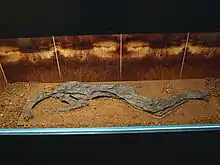Damendorf Man
Damendorf Man is a German bog body discovered in 1900[1] in the See Moor at the village Damendorf in Schleswig-Holstein, Germany.
Display and examination

The remains are on display at the Archäologisches Landesmuseum. Professor P.V. Glob wrote that the man died in 300 BCE. What is unique about this bog body is the fact that the weight of the peat in the bog had flattened his body.[2] Only his hair, skin, nails and his few clothes were preserved, along with traces of some bones.[2][3] He was found with a leather belt, shoes, the parts of a pair of woolen breeches and a pair of woolen puttees.[4]
 Single parts of the breeches
Single parts of the breeches Tablet wefts on the breeches cloth
Tablet wefts on the breeches cloth Puttees
Puttees Shoes
Shoes
Other finds
Prior to the Damendorf Man's discovery, the remains of what are believed to be a woman were found in 1884 in the same bog. The clothing of the corpse is all that remains. A girl was discovered in 1934, dating to 810 BCE.[5]
References
| Wikimedia Commons has media related to Mann von Damendorf. |
- Aldhouse-Green, Miranda (2015-09-08). Bog Bodies Uncovered: Solving Europe's Ancient Mystery. Thames & Hudson. ISBN 978-0-500-77298-0.
- Gill-Robinson, Heather (2005). The Iron Age Bog Bodies of the Archäologische Landesmuseum Schloss Gottorf.
- Damendorf Man Archived 2011-07-21 at the Wayback Machine. Mummytombs.com. Retrieved on 15 September 2011.
- Archaeology Magazine – Bodies of the Bogs – Clothing and Hair Styles. Archaeology.org. Retrieved on 15 September 2011.
- Van der Sanden, Wijnand (1996). Through Nature to Eternity. p. 104.